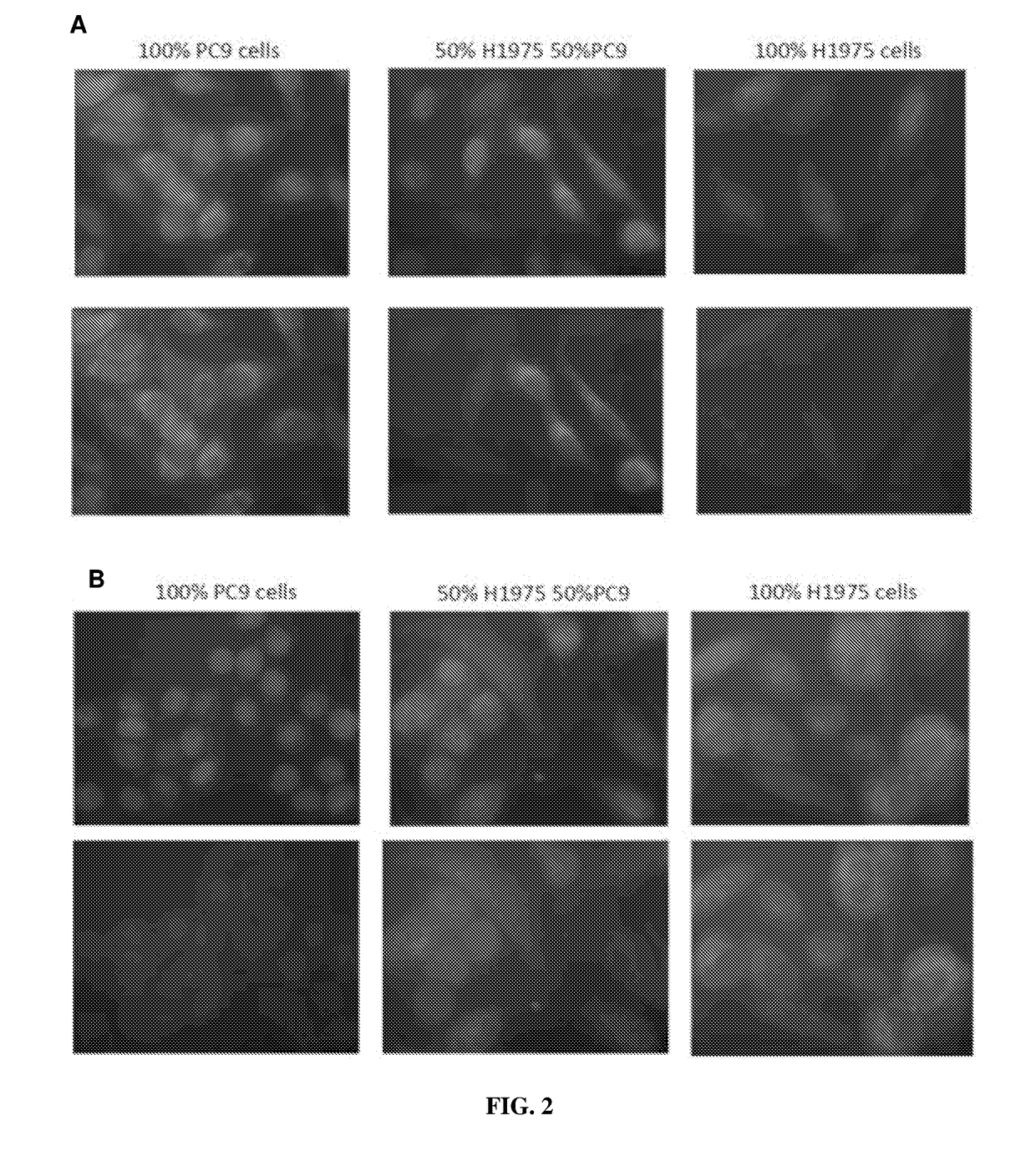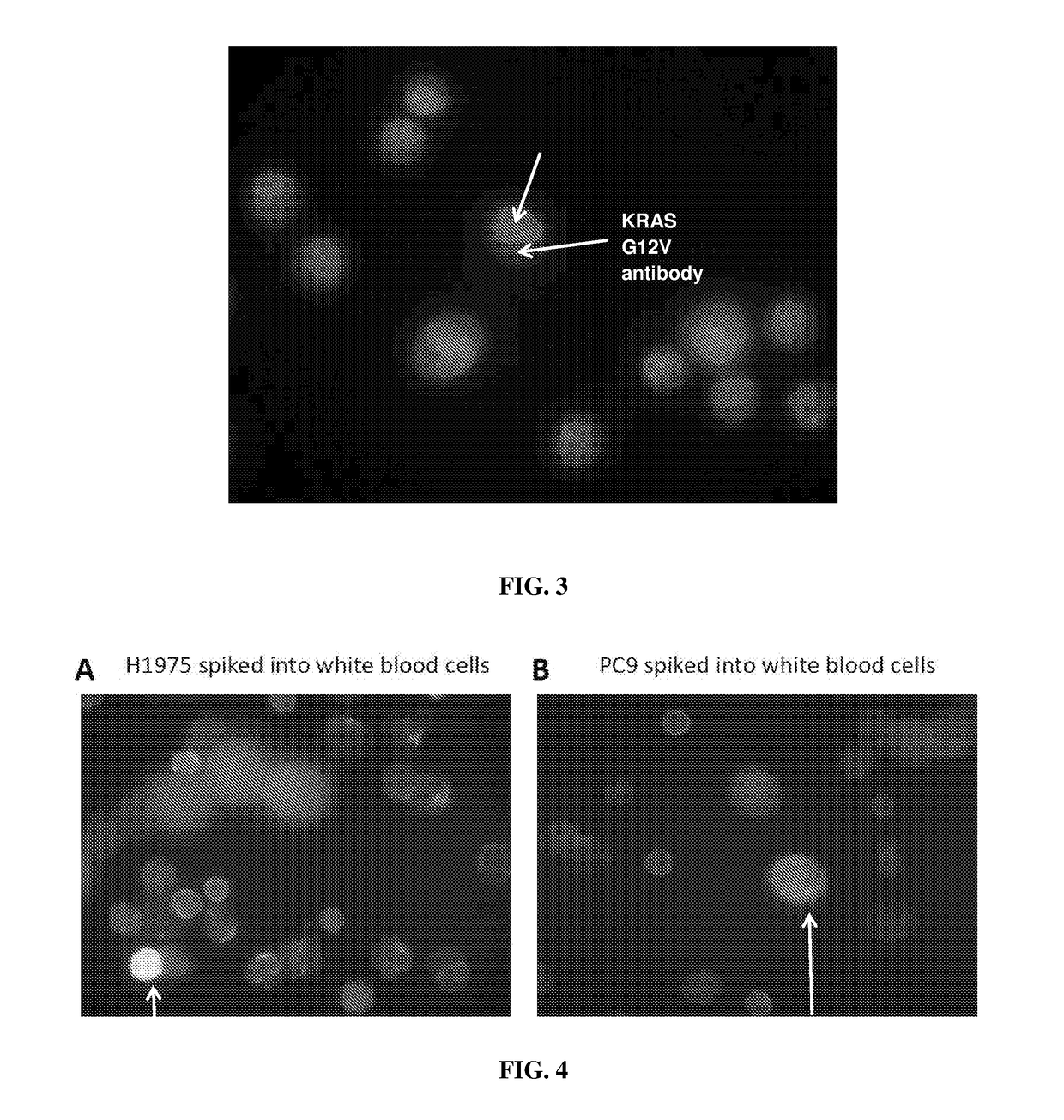Method for detecting circulating tumor cells and uses thereof
a tumor cell and detection method technology, applied in the field of biochemistry, can solve the problems of ctcs detection remaining a technical challenge, affecting the diagnosis or prognosis of cancer, and affecting the use of ctcs for cancer diagnosis or prognosis,
- Summary
- Abstract
- Description
- Claims
- Application Information
AI Technical Summary
Benefits of technology
Problems solved by technology
Method used
Image
Examples
example 1
pecificity of Mutation-Specific Antibodies
[0067]In order to test the specificity of the antibodies, Western blot analysis was carried out using EGFR L858R and EGFR exon19 (ΔE746-A750) antibodies on H1975 (with known EGFR L858R mutation) and PC9 (with known EGFR exon19 (ΔE746-A750) mutation), and using KRAS G12V antibody on SW620 (with known KRAS G12V mutation) and PC9 (known as negative for KRAS-G12V), according to the following protocol:
[0068]1. The cell lysate from PC9, H1975 and SW620 cancer lines were harvested using RIPA buffer added with protease inhibitor and incubated at 4° C. for 30 minutes.
[0069]2. The lysate was sonicated for three times for 30 seconds.
[0070]3. The protein was denatured at 99° C. for 5 minutes in laemmli buffer.
[0071]4. Equal amount of samples were loaded to the polyacrylamide gel and electrophoresis was performed at constant 20 mA for 1 hour in Tris Glycine SDS running buffer.
[0072]5. The protein was transferred to polyvinylidene difluoride (PVDF) membra...
example 2
Tumor Cells Using Mutation-Specific Antibodies
[0078]Immuno-fluorescent experiment was carried out to detect tumor cells in the samples using mutation-specific antibodies EGFR L858R and EGFR exon19 (ΔE746-A750) according to the following protocol:
[0079]1. Cytospin was performed on approximately 100,000 cells.
[0080]2. The cells were incubated with FcR blocking reagent for 15 mins at 4° C. followed by CD45 staining for 30 minutes at 4° C.
[0081]3. The cells were washed for three times followed permeabilization with 0.1% Triton-X for 10 mins at room temperature.
[0082]4. The blocking buffer supplemented with goat serum was added to the sample and incubate for 1 hour.
[0083]5. Primary antibody was added to the sample followed by overnight incubation at 4° C.
[0084]6. Secondary antibody was added to the sample followed by 1 hour incubation at room temperature.
[0085]7. DAPI stain was added to the sample and the slide was mounted with coverslip before visualization on the microscope.
[0086]A ser...
example 3
Tumor Cells in Blood Samples from Healthy Subjects Spiked with Tumor Cells
[0088]To simulation samples containing CTCs, blood samples from healthy subjects were collected and spiked with cancer cells H1975 or PC9. The ratio of the spiked cancer cells and the healthy blood cells is 1:9 (10% of cancer cells and 90% of healthy blood cells). The cells were mixed gently and immunofluorescence assay was carried out according to the following protocol:
[0089]1. Cytospin was performed on approximately 100,000 cells.
[0090]2. The cells were incubated with FcR blocking reagent for 15 mins at 4° C. followed by CD45 staining for 30 minutes at 4° C.
[0091]3. The cells were washed for three times followed permeabilization with 0.1% Triton-X for 10 mins at room temperature.
[0092]4. The blocking buffer supplemented with goat serum was added to the sample and incubate for 1 hour.
[0093]5. Primary antibody was added to the sample followed by overnight incubation at 4° C.
[0094]6. Secondary antibody was add...
PUM
| Property | Measurement | Unit |
|---|---|---|
| time | aaaaa | aaaaa |
| time | aaaaa | aaaaa |
| time | aaaaa | aaaaa |
Abstract
Description
Claims
Application Information
 Login to View More
Login to View More - R&D
- Intellectual Property
- Life Sciences
- Materials
- Tech Scout
- Unparalleled Data Quality
- Higher Quality Content
- 60% Fewer Hallucinations
Browse by: Latest US Patents, China's latest patents, Technical Efficacy Thesaurus, Application Domain, Technology Topic, Popular Technical Reports.
© 2025 PatSnap. All rights reserved.Legal|Privacy policy|Modern Slavery Act Transparency Statement|Sitemap|About US| Contact US: help@patsnap.com



